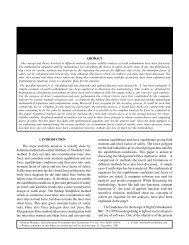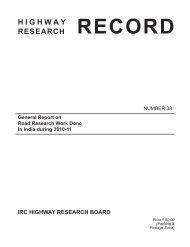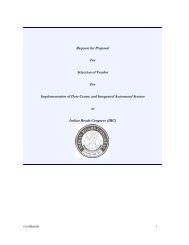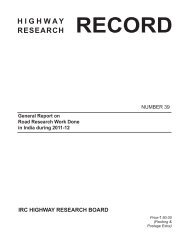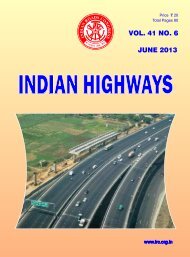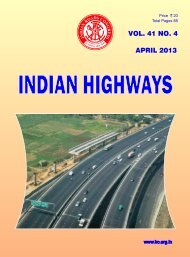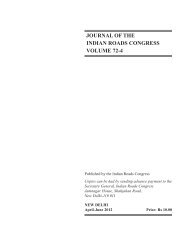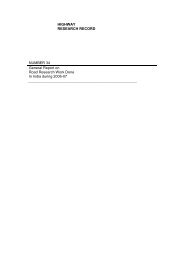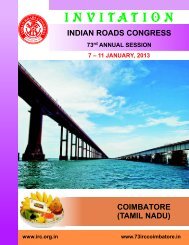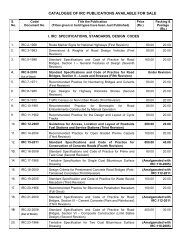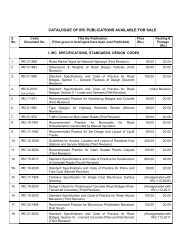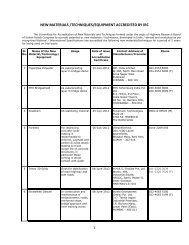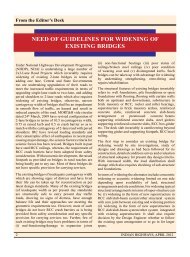A Review of Highway Agencies in the South Asia Region
A Review of Highway Agencies in the South Asia Region
A Review of Highway Agencies in the South Asia Region
Create successful ePaper yourself
Turn your PDF publications into a flip-book with our unique Google optimized e-Paper software.
A <strong>Review</strong> <strong>of</strong> <strong>Highway</strong> <strong>Agencies</strong> <strong>in</strong> <strong>the</strong> <strong>South</strong> <strong>Asia</strong> <strong>Region</strong><br />
C 3 Sweden<br />
C.3.1 Introduction to Roads <strong>in</strong> Sweden<br />
Classification <strong>of</strong> Roads and Management<br />
The road network <strong>in</strong> Sweden can be classified <strong>in</strong>to <strong>the</strong> follow<strong>in</strong>g types:<br />
State roads (98,400 km);<br />
Municipal roads (41,00 km); and<br />
Private roads (284,000 km).<br />
Until recently, Sweden ma<strong>in</strong>ta<strong>in</strong>ed vertical separation <strong>of</strong> its modes <strong>of</strong> transportation. The<br />
Swedish Road Adm<strong>in</strong>istration (SRA) was <strong>the</strong> lead agency for <strong>the</strong> country’s road network.<br />
As SRA was responsible for national and regional roads, <strong>the</strong>re are only a few o<strong>the</strong>r road<br />
<strong>in</strong>frastructure providers with whom it dealt. Although 90 percent <strong>of</strong> <strong>the</strong> almost 300<br />
municipalities have responsibility over some <strong>of</strong> <strong>the</strong> roads <strong>in</strong> <strong>the</strong> most populated areas, this<br />
basically only concerns <strong>the</strong> municipalities <strong>of</strong> major cities. No counties or un<strong>in</strong>corporated<br />
areas exist <strong>in</strong> Sweden. Cooperation with local government is needed for traffic management<br />
and ma<strong>in</strong>tenance works, but SRA also built close contact with local governments on<br />
o<strong>the</strong>r issues. Us<strong>in</strong>g outreach, promotion <strong>of</strong> best practices, benchmark<strong>in</strong>g, small grants to<br />
encourage behavior, and cont<strong>in</strong>uous dialog, SRA extended national government objectives<br />
<strong>in</strong>to <strong>the</strong> practices, processes, and projects <strong>of</strong> <strong>the</strong> local municipalities. A substantial part <strong>of</strong><br />
<strong>the</strong> Swedish road network is <strong>in</strong> private hands, largely <strong>in</strong> those <strong>of</strong> timber companies. The<br />
ma<strong>in</strong>tenance <strong>of</strong> some <strong>of</strong> <strong>the</strong>se roads was be<strong>in</strong>g subsidized by SRA <strong>in</strong> view <strong>of</strong> <strong>the</strong>ir availability<br />
for public transport services.<br />
Although, <strong>in</strong>dependently, <strong>the</strong> separate transport modes became quite developed, synergies<br />
were needed to br<strong>in</strong>g <strong>the</strong> transport network as a whole to <strong>the</strong> next level. So, <strong>in</strong> April 2010,<br />
<strong>the</strong> Swedish Transport Adm<strong>in</strong>istration (STA) was established to br<strong>in</strong>g <strong>the</strong> management<br />
<strong>of</strong> road, rail and transport communications under one ro<strong>of</strong>. The Swedish Rail and Road<br />
Adm<strong>in</strong>istrations as well as <strong>the</strong> Swedish Institute for Transport and Communications Analysis<br />
have been phased out.<br />
Restructur<strong>in</strong>g <strong>of</strong> <strong>the</strong> transport network was aimed at streng<strong>the</strong>n<strong>in</strong>g <strong>the</strong> management <strong>of</strong> <strong>the</strong><br />
transport system. Clarity was provided to roles, responsibilities and targeted outputs <strong>of</strong> <strong>the</strong><br />
lead agency as well as <strong>the</strong> core group <strong>of</strong> m<strong>in</strong>istries and agencies to be <strong>in</strong>volved. Changes<br />
brought about to <strong>the</strong> three ma<strong>in</strong> support<strong>in</strong>g bodies for <strong>the</strong> road network are:<br />
The Swedish Transport Agency was established by Swedish Parliament to enforce<br />
public authority for <strong>the</strong> entire transport sector, tak<strong>in</strong>g over tasks <strong>of</strong> <strong>the</strong> Traffic Registry,<br />
Road Traffic Inspectorate and parts <strong>of</strong> SRA’s public authority activities;<br />
Vägverket Produktion, engaged <strong>in</strong> construction, operation and ma<strong>in</strong>tenance <strong>of</strong> road and<br />
civil works projects, would become corporatized under <strong>the</strong> name Svevia; and<br />
SRA Consult<strong>in</strong>g Services was planned to jo<strong>in</strong> Banverket Consult<strong>in</strong>g as a state company<br />
called Vectura Consult<strong>in</strong>g AB.<br />
In addition, Transport Analysis is a separate entity responsible for <strong>the</strong> evaluation <strong>of</strong> facts,<br />
statistics and o<strong>the</strong>r data for <strong>the</strong> decision-mak<strong>in</strong>g process.<br />
Much <strong>of</strong> <strong>the</strong> documentation on road transport matters used <strong>in</strong> this report largely refers to<br />
SRA. For convenience, both <strong>the</strong> activities and performance as currently carried out by <strong>the</strong><br />
STA or <strong>in</strong> <strong>the</strong> past by <strong>the</strong> SRA are described here.<br />
Utilization <strong>of</strong> <strong>the</strong> Network<br />
Over <strong>the</strong> past decade, road transport has cont<strong>in</strong>ued to make up a large part <strong>of</strong> total<br />
transport mileage <strong>in</strong> Sweden. Passenger transport mileage by road was 79.4 percent <strong>in</strong><br />
1999, compared with 86.6 percent <strong>in</strong> 2008. Utilization here is measured by <strong>the</strong> number<br />
<strong>of</strong> km driven by vehicles on each type <strong>of</strong> road. While state roads comprised only about a<br />
137



